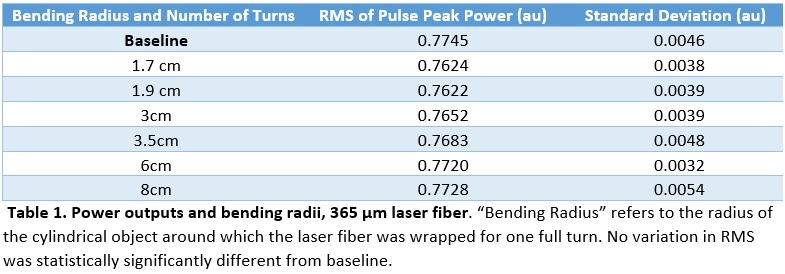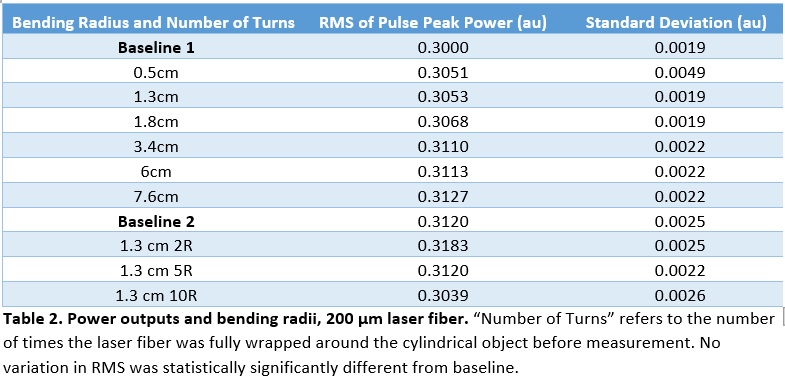The Effect of Holmium Laser Fiber Bending Radius on Power Delivery During Flexible Ureteroscopy
Dylan Heckscher, AB1, Junjie Zeng, BS2, Panagis Samolis, BS2, Michelle Y. Sander, PhD3, Shaun Wason, MD4, David S. Wang, MD4
1Boston University School of Medicine, Boston, MA, 2Boston University Department of Electrical and Computer Engineering and BU Photonics Center, Boston, MA, 3Boston University Department of Electrical and Computer Engineering and BU Photonics Center, Boston, MA; Boston University Division of Materials Science and Engineering, Brookline, MA, 4Boston University School of Medicine/Boston Medical Center, Boston, MA
Background: Holmium laser lithotripsy has become standard for ureteroscopic management of urinary tract stones. During flexible ureteroscopy, laser fibers may be subject to multiple sharp bends depending on stone location. It remains relatively unknown whether power delivery at the fiber tip changes due to fiber curvature. We evaluated whether bending angles affect the power output of a commonly used holmium laser. Materials and Methods: We used a Lumenis Pulse 30H Holmium Laser, a standard mirror, a collection fiber with a 400 Ám core diameter, a Thorlabs Amplified Si Photodetector, and a Tektronix MSO702004 Oscilloscope. Two commonly used laser fibers were used: a SlimLineTM SIS 365, and a SlimlineTM 200 D/F/L. The laser fiber and collection fiber were positioned in parallel, pointing downwards at a small mirror. The mirror and the fiber tips were then submerged in deionized water. The laser was fired at 0.3 J/5 Hz without any significant bend to establish a baseline. For subsequent testing, a portion of the laser fiber was horizontally and tightly wrapped around cylinders of varying radii. The fiber was wrapped one or more full revolutions around the cylinders, and the power output recorded over eight seconds. The peak values were used to calculate a Root-Mean-Square (RMS). Due to experimental setup variations, three baselines were taken. The smallest radii used are the smallest radii each fiber could achieve without breaking. Results: The RMS of pulse peak power did not vary significantly at any bending radius or number of turns measured. The Oscilloscope is accurate within 2% of measurement. Because our experiment compared two values, any measured power output difference of less than 4% was within the margin of error. At the tightest radius measured, the 365 Ám fiber was measured as transmitting 1.6% less power than baseline - within the measurement uncertainty. At the tightest radius measured for the 200 Ám fiber, the power output was measured as 1.7% more powerful than baseline - within uncertainty. After wrapping the 200 Ám fiber 10 times at the smallest radius it would accept without breaking, the power was measured to be 2.6% lower than baseline, again within the 4% margin of error. In none of the cases did the fiber break or degrade. Measured power outputs are summarized in Tables 1 and 2. Conclusions: We found no difference in peak power delivery in two different laser fiber types bent at various radii. Unless the laser fiber breaks, there will be no measurable difference in power delivery from bending alone under surgical conditions. This result was consistent to the smallest radius and highest number of turns the fiber could reliably undergo without breakage. Endourologists can trust that laser output will be stable during ureteroscopy regardless of stone location.


Back to 2019 Abstracts
